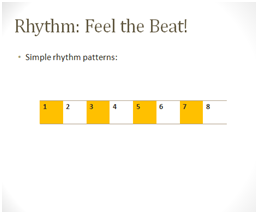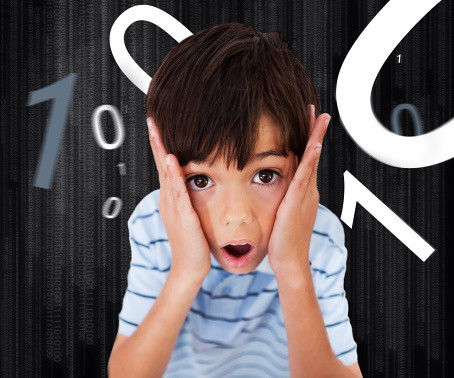It is stated by Galileo Galilei (1623, quoted in Rosenthal, 2005) that the world “is written in the language of mathematics”. There are so many aspects of music that are maths based but nobody really ever stops to think about the mathematical elements within music. The rhythm, tempo, note values, beats in a bar, scales etc.
At high school I studied Music and I really enjoyed it. It had never occurred to me that mathematics was heavily involved within music until now. We had a lecture last week about how mathematics is involved in making music. Something so simple as the rhythmic pattern within a musical composition shows the mathematical links. We actually tried some clapping sequences ourselves to prove this. Our lecturer, Anna, gave us the opportunity to clap out some rhythms so that we could see that counting and speed were involved in this activity. The picture shown below is what we used, the yellow boxes told the class when to clap and the white boxes were to indicate a rest. Anna split us into groups and allowed each group to perform a particular clapping sequence. We then added them all together so that the rhythm over lapped one another.
The picture shown below is what we used, the yellow boxes told the class when to clap and the white boxes were to indicate a rest. Anna split us into groups and allowed each group to perform a particular clapping sequence. We then added them all together so that the rhythm over lapped one another.
After the lecture I reflected on what activities I can use in my professional practice. This activity is simple but effective and most importantly fun. Using the colours to indicate who claps when encourages children to get involved without getting confused. Beginning a maths lesson with a clapping pattern does not only encourage music but maths, as there is counting, speed and rhythm involved. This also enables the children to be engaged and encourages cross- curricular teaching.
In the lecture we also discussed the Fibonacci Sequence and how it relates to music. I discovered that “there are 13 notes in an octave and a scale is composed of 8 notes” (Robb, 2015). We discussed the Fibonacci sequence in another lecture, earlier that week, and I was not very confident in my knowledge so I decided to use my initiative. I decided to read some online resources which explored how it effects music. It is stated that The Fibonacci sequence consists of particular numbers, some of them are 1,1,2,3,5,8,13…, these numbers continue and there is no end to them (Iyer, 2009). Iyer (2009) states that the sequence is also linked with the Golden Ratio, “…the ratios of two successive Fibonacci numbers…this ratio gets closer and closer to…the “golden ratio” :1.6180339887.” This number gets used within many different activities such as art, architecture and also used by composers to create music. The Fibonacci Sequence is used “when composing music to make patterns of notes that are pleasing to the ear.” (Passy, 2011).
Having time to digest the information I received in the maths lecture and also researching more information has allowed me to have a better understanding of the Fibonacci Sequence. I am glad I have taken this maths elective as I feel that I am extending my knowledge of how maths is not just ‘a subject’ within the primary classroom but it exists within everything that we do.
References
Iyer, V. (2009) Strength in numbers: How Fibonacci taught us how to swing. Available at: http://www.theguardian.com/music/2009/oct/15/fibonacci-golden-ratio (Accessed on: 10 November 2015).
Passy. (2011) ‘Fibonacci Sequence in Music’, Passy’s World of Mathematics, 26 July. Available at: http://passyworldofmathematics.com/fibonacci-sequence-in-music/ (Accessed: 10 November 2015).
Robb, A. (2015) ‘Discovering Maths: Music’. [PowerPoint presentation] ED21006: Discovery mathematics (University Elective). Available at: https://my.dundee.ac.uk/webapps/portal/frameset.jsp?tab_tab_group_id=_2_1&url=%2Fwebapps%2Fblackboard%2Fexecute%2Flauncher%3Ftype%3DCourse%26id%3D_54593_1%26url%3D (Accessed on: 10 November 2015).
Rosenthal, J. (2005) Plus Maths. Available at: https://plus.maths.org/content/magical-mathematics-music (Accessed on: 10 November 2015).


